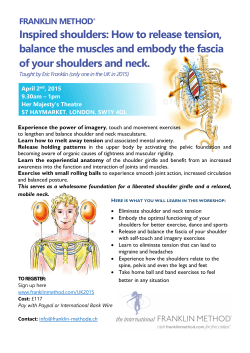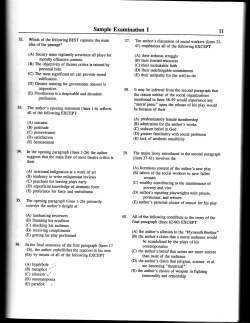
9th English Monkey See PDF
Monkey See, Monkey Do, Monkey Connect English 1 p.123-128 Read page 123 Chimpanzees share more genetic traits with humans than other primates do. In fact, they share about 98 percent of the same DNA. Researchers have been studying primate behavior for nearly a century; this research has taught us much about human beings as well. The Yerkes National Primate Research Center is one of eight similar institutions in the United States that are funded by the National Institutes of Health. You can use context clues – words that are used in a sentence or surrounding sentences in a way that suggest the meaning of another word – to determine the meanings of unknown words, including technical terms. 1. How does context help you understand the meaning of the word epidemics in line 3? Cite specific words and phrases from the text. In some informational texts, the writer presents one or more claims, or positions, on a specific issue and supports them with reasons and evidence. Reasons justify claims; evidence supports reasons with facts and examples. 2. What claim does the author make in the first paragraph, and what reasons and evidence does he use to support his claim? Cite examples from the text. Share your answer with your shoulder partner. (2 min.) Read page 124 An allusion is an indirect reference to a well-known person, place, event, or literary work. 3. How does the allusion to Crusoe develop the author’s idea that “we’re all interconnected”(line 23)? 4. Review the definition of synchronization in line 30. Think about the definition given and use context clues to explain what synchrony (lines 47-51) means. Share your answer with your shoulder partner. (2 min.) 5. How does “running when others run” relate to empathy? 6. How does synchronization explain some human and primate behavior? 7. How does de Waal’s story about the lecture on yawning illustrate the idea of contagion? Share your answer with your shoulder partner. (2 min.) Read page 125 The context for some terms may be several sentences or a lengthy paragraph that describes an example. 8. The term herd instinct is first used in line 63. How does the context of the paragraph provide clues to the meaning of the term? An author chooses the words to create a specific tone – to convey his or her attitude toward the subject. 9. Read the description of Tony Blair and George W. Bush in lines 73-79. What impact does the use of the words swagger and strutted have on the tone of the paragraph? A claim may follow from the presentation of evidence. 10. Reread lines 84-102 about the “ghost box” and explain the experiment’s conclusion. Based on this evidence, what claim does the author make? 11. Has the author provided relevant evidence to support his claim (from Question # 11)? Share your answer with your shoulder partner. (2 min.) Read page 126 Speakers and writers often include multiple examples to strengthen a claim. 12. Identify three examples in the text that show ways in which “bodies insert themselves into everything we perceive or think” (lines 110111). Look for clues in the text that show what a technical term means. 13. Look at the term body mapping in line 129. What context clues suggest the meaning of this term? What does body mapping mean? 14. How does “embodied” cognition explain some human and primate behavior? 15. Explain what implications the study of “embodied” cognition might have. Share your answer with your shoulder partner. (2 min.) Read page 127 Authors often use synonyms, or words with similar meanings, to make their writing less repetitive and to express subtle shades of meaning. 16. Locate the word mimicry in line 149 and identify several terms in surrounding text that have similar meanings. 17. Which synonym is closest in meaning to mimicry? Toward the end of an essay, an author may support previous claims with more reasons and evidence. 18. Reread de Waal’s statement in lines 154-155: “The new level requires that one pay better attention to what others do and absorb how they do it.” What implications do this statement and the subsequent examples suggest? Share your answer with your shoulder partner. (2 min.) Read page 128 One way to understand technical vocabulary is to visualize the context. 19. Locate the word nodes in line 178. Visualize what the sentence is describing. What does the context suggest that the word means? 20. What is de Waal’s claim about how humans are connected? Discuss the examples he provides in support of his ideas. Share your answer with your shoulder partner. (2 min.)
© Copyright 2025





















